This post is sponsored by Home Depot
I’ve always been intrigued by hybrid multi headed tools. I remember really considering a Shop Smith when I was in my 20’s. In the end I decided dedicated tools were more efficient for my needs. At the other end of the spectrum are drills with interchangeable heads. I really like them for many reasons so I have several. I have known about other systems with many tool attachments but I stayed away from them since they were light duty tools for homeowners.
The first multihead tool that I used and liked was the Ridgid Jobmax oscillating multitool. (Check the review here) It was surprisingly solid and powerful. It performed better than some dedicated multitools. There are quite a few attachments for it. While I haven’t used all of them, most seem to be well made.
The new Mega Max Tools are now here!
Since the first time I saw a picture of these new extra duty tools I have wanted to use them to see how they compare to current dedicated top-tier tools. They really seemed to be a powerful yet economical solution to many a tradespersons needs. With this system you can basically have two heavy-duty tools for the price of one. The third SDS plus head is a lot less money than a third dedicated tool. We are used to single use tools but face it tools are very expensive and for most of us we can only use one at a time.
I finally got my hands on them a few months back and let me tell you they do not disappoint! The power head is straight up beef?! I don’t know the actual wattage of the motor but it’s ample for the tool heads included. The coupling is mostly metal for strength and durability. There are some plastic areas for smooth engagement. The actual drive gear is a tough rubber piece that looks like it can really take a beating.
To attach a tool head you need to hold the power head at a 45° angle in relation to the head. Engage the two pieces and twist. It will have a positive click and then a flash of the status led and a chime to let you know it is ready for action. To disengage simply slide the unlock button, twist 1/8 turn and pull apart. It’s such a slick system. Changing power heads is just as easy as changing a battery on most power tools. I don’t find it inconvenient at all.
Each tool compares very well to class favorites.
This was something I wasn’t sure about until I tried them out myself at the Home Depot Prospective event in New York City. I purposely tried to stall the right angle drill with the bits they had on hand and couldn’t do it. All I got was a strong performance from each tool and that’s what I am finding here as well. On the job and in the shop they are pulling their weight and then some.

The tool I was most interested in was the reciprocating saw. In remodeling and fire and water damage restoration work we do far more demolition than right angle or concrete drilling.
When configured as a reciprocating saw it is just slightly longer than the class leaders from Milwaukee and Makita. With a 6.0 battery it weighs 10 pounds 12 ounces which isn’t too bad for such a powerful tool.
There is no extra rattling and just a little more vibration with the MegaMax recip than other saws on the market. The tool free blade clamp seems to work fairly well. It is not as smooth and easy to use as the Makita or Bosch saws but it seems well designed. It is closer to the old style Milwaukee clamp. Right now it is easier to insert a blade than it is to take it out. If that changes as it breaks in I will update as needed. The adjustable shoe is something I wish all saws had. It increases blade life considerably, especially in metal. One thing missing is a rafter hook.
With the MegaMax reciprocating saw you get straight line cutting and orbital action. This has been a feature sorely lacking in cordless tools until recently. Ridgid was one of the first to offer it in their gen 4x and 5x 18v Saws. Now Bosch and Milwaukee also offer it in their newest saws. Orbital mode essentially thrusts the teeth into softer materials (not generally used on metal) for a deeper bite with each stroke. It’s almost always faster than straight mode on any saw. This not only saves time on each task, it also reduces the time your hands, wrist and elbows are subjected to the vibration.
This is no small matter. When I am doing comparison tests on recip saws my elbows wrists and hands ache for weeks after the tests are over.
On speed and power tests the MegaMax performed well. It is in the middle to upper half of the class as far as I can tell. I would put it up against any current cordless recip saw for most tasks. It looks like these are aimed at contractors more than past Ridgid offerings. It is far far better than any of the cordless tools I bought when I was starting out.
 The right angle head is not as frequently used in my work but it is no less impressive. It is absolutely a workhorse of a drill. I am not a plumber or electrician. We almost always sub those trades out to licensed professionals. The only time we don’t is if it is in a rural locality that doesn’t require it and we can’t get subs to do the job. Nevertheless we do still have to drill joists and studs occasionally and this drill is just crazy powerful. In one test with a 4 5/8” self feed bit it actually got through a 2 x12 faster than the DeWalt 60 volt stud and joist drill. This makes me think it will outperform the Superhawg as it is well-known to be less powerful than the DeWalt.
The right angle head is not as frequently used in my work but it is no less impressive. It is absolutely a workhorse of a drill. I am not a plumber or electrician. We almost always sub those trades out to licensed professionals. The only time we don’t is if it is in a rural locality that doesn’t require it and we can’t get subs to do the job. Nevertheless we do still have to drill joists and studs occasionally and this drill is just crazy powerful. In one test with a 4 5/8” self feed bit it actually got through a 2 x12 faster than the DeWalt 60 volt stud and joist drill. This makes me think it will outperform the Superhawg as it is well-known to be less powerful than the DeWalt.
It comes with a solid side handle to help you handle all that torque. I know a lot of guys laugh at side handles. I don’t recommend laughing at this one. The overall length is shorter than the Superhawg so you have less leverage with which to control it if the bit binds. I didn’t seem to be able to find a mechanical clutch. I think it’s all electronic. When the bit binds the tool shuts off. The margin is pretty high so you are going to feel it. At the point where it stalls the DeWalt and Milwaukee’s are already clutched out mechanically This is NOT a tool to use while distracted! It can and will smack you.
One complaint I have early on is the chuck key and storage. It is not a standard key. It is an angular cast piece and I feel it is uncomfortable when trying to loosen bits. The other issue is it falls out of the storage slot easily. I feel it will get lost all too easily. Also the slot is in the upper head handle. If you need to remove it for any reason there goes your slot. The keys and storage are much better on the DeWalt and Milwaukee offerings.
 The third head is the SDS plus rotary hammer. As with the other head it performs very well. I’ve used it side by side with some of the best on the market and it is right there on speed and power. It effortlessly drills concrete and with 2 ft lbs of impact energy it will easily outperform the biggest hammer drills while making less noise. In addition to the regular drill and hammer mode you can use it for chipping. This is always a desired feature on a rotary hammer. It makes tile removal a breeze. It can also be used on light chipping of concrete. It’s not for breaking out a basement floor or sidewalk but it does great on smaller tasks.
The third head is the SDS plus rotary hammer. As with the other head it performs very well. I’ve used it side by side with some of the best on the market and it is right there on speed and power. It effortlessly drills concrete and with 2 ft lbs of impact energy it will easily outperform the biggest hammer drills while making less noise. In addition to the regular drill and hammer mode you can use it for chipping. This is always a desired feature on a rotary hammer. It makes tile removal a breeze. It can also be used on light chipping of concrete. It’s not for breaking out a basement floor or sidewalk but it does great on smaller tasks.
It will be fun and interesting to see how these tools hold up over time. We will periodically update on how they are doing. The lifetime service agreement should reduce any worries in that regard. Just don’t forget to register them. These are available only at Home Depot. You can order them in the link below.


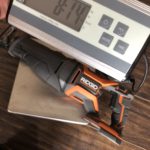
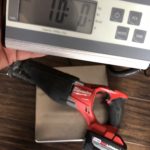
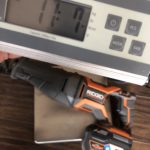
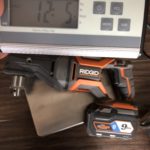
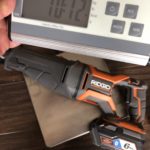
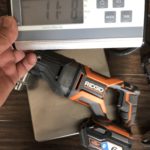





Would totally use this to finish the remodel in my kitchen!!! Can already imagine what projects could get completed ASAP! Lol!
FB @ EmilyMMarshall
forgot to add my IG @ androd1983
Just purchased a Ridgid Hammer Drill/Impact combo. Absolutely love them! This would be an amazing addition to my growing tool collection!
IG @ androd1983
Great to put in any collection of tools to get the job done on any remodel…
IG @now.we.are.5
This would be a great addition to the tool arsenal, don’t have too many cordless power tools
I have some remodel work to get started on and this would be a big help.
Do a little everything .
I think this will eliminate having to carry so many tools also save money instead having to buy two separate tools …would be great #new #homeremodeler
Would really come in handy remodeling houses here in southern California
This would really help me remodeling houses here in southern California
Been an industrial gas fitter doing service work for the last few years. Did retrofit installs for 10 years before that and most of my tools are corded and worn out. It’s hard to justify spending a hundreds in tools that only get used a handful of times a month to not have to pull out extension cords when there are kids and a mortgage. Victoria BC Canada. IG@jonhcole
I am really intrigued by the removable head. Any tool that dpubles as another seems pretty efficient for any jobsite!
The new Ridgid Mega Max Is a highly versatile tool for any level of builder. I would use this to help complete the water heater closet that had to be expanded to fit the 75 gallon replacement. I am a pen maker/designer as well as a Logistics Manager by day.
This is an awesome setup. My father in law is looking to build a cabin and it would be perfect to help get the job done!
@grafdad
Something like this setup would be great
When you’re working away from many amenities and have to pack in everything you need to buil. The efficiency of it all makes so much sense when you’re not using a dedicated tool every day.
(Sorry, forgot to actually finish the thought earlier)
I was looking into this kit about 2 or 3 weeks ago on the Home Depot site for one of their special buy promotions. The MEGAMAX kit is way more cost effective and much easier for storage purposes Instead of storing 2 different tools. All of my tools are ridgid due to their life time warranty. I found they have your back 100% of the way, if something happens you don’t have to worry about dropping 1-200$ on a new tool to finish a job. This would be useful for jobs because I am often building and repairing decks where the right angle could really come In handy underneathe and the reciprocating saw for 4×4 posts and joists. Overall great idea and great product on ridgids end, a big purchase is in the future for me!
I like the versatility. The idea that you can have several tools on the same motor is intriguing. As a remodeling contractor I can see how this would be very useful for us. Love to try and it out and see if could convince me to switch from my dewalt platform…
Insight Design Build Remodel -Instagram
Insight Construction and Remodeling- FB
Thanks for the review! Saw this in HD the other day and at first thought, ehh, cool concept but a little bulky and how well could it work? After seeing your demo I could see myself saving a LOT of room with one of these bad boys, plus many of its brother heads to swap out. As a newly licensed B1 contractor and Handyman in California this would be an awesome tool to have and save me some much needed space since I still carry everything in my truck. Thanks TP!
I really would love this setup. I am in limited space and having one platform that can do all sorts of tasks would be a awesome. I am just beginning my career in home remolding. Right now I am using all corded harbor freight tools and it would be a huge jump to have something as nice as this. Also the lifetime warranty would another amazing feature that I could use.
Wow what a give away!! Excited to enter my chance to win! This is one of the best interchangable tools I’ve seen yet. I own a black and decker drill maxx interchangeable head, which was discontinued. But loved the choice of action. Yet to see how many choices of heads come with this ridgid model. For this the first time I run into something like this from ridgid. Its been over a few years since I had to or even been able to buy my choice of tool. I remodel but mostly work at home trying to build new ideas. Just got into carpentry and loving the trade, but a black and decker can’t handle heavy duty. Nor medium in that matter. Thank you for you’re time.
-Martin
I love the idea of saving space. Working out of a truck with a truckbox to store my tools means space is always at a premium. For ridgid to introduce a quality product for us remodelers that saves space sounds awesome. Great review as always!
I have yet to get into the Ridgid cordless world. I have several corded Ridgid tools, and find them to range from adequate to good. I have a small handyman business that is in desperate need of a right angle drill but have not been able to justify it yet with the makita 36v being almost $500. Your videos show a strong saw that would be good both in my secular work and volunteer activities that range from building to disaster relief.
@thefatterkirby I want this cause my dad made me enter
After being halfway invested in the platform, I would love to add this to the arsenal. The same as you, I’m in the insurance business and do a lot more demo than anything else. Hopefully this can be powerful enough to keep the corded sawzall in the truck.
Dude this thing rocks from what I’ve seen! I’m currently applying for my state cert gc license in Florida, my test is in December. Would love to add something like this to my arsenal!! Thanks for all your reviews!!
@keithsheehan
I love the idea of having a tool that does more than one thing, and since I am new in construction, I don’t have many tools to work with that are mine. I would love to grow my collection. 🙂
Seems like an awesome product. Love the versatility to switch heads instead of carrying multiple tools
I’m entering for my son who started last year. @fagadaddy
Handy man, landlord and property manager here…limited space in the truck and this thing looks like a beast! Just purchased the GEN5 brushless kit and I’m loving the performance of Ridgid!
Paul, this is a very thorough review of this tool. I bought a set of Ridgid cordless tools a few years ago and really wasn’t impressed. From your review it might be worth another shot. I’m a carpenter and am in Mexico Missouri USA
@a_and_e_designs
With my Milwaukee right angle making a grinding noise with every revolution and my old school allen key blade removal Milwaukee sawzall sporadically shooting sparks, i have been long overdue for an upgrade. I have been tossing around going cordless with both. This would be the icing on the cake having interchangeable heads.
I bought the Ridgid brushless hammer drill and impact driver kit a little over 2 1/2 years ago and have been very pleased with the power, runtime and build quality. Since then I’ve add many of their 18v tools to be arsenal and have very few complaints on all of them. From what I’ve seen the MegaMax is very well designed and has good build quality, both of which are unfortunately lacking on many other multi head systems out there. And the MegaMax is undoubtedly the most advanced and powerful yet. I haven’t heard anything yet but I assume they’ll introduce more heads for it and that’s very exciting for anyone who is looking at this system. Personally I’d like to see a high torque impact wrench head, winch head, water pump head and maybe even a miter saw head. Think about it. The handle is right for a miter saw and it looks to have the power. Overall I’m definitely considering picking one up for work around the house and shop, and as I get into the trades it could be just what I need.
Im young and just got my red seal as a plumber. I live in a small town with a low economy so I work a lot on the weekends doing odd jobs and so on. With my new license , I’ve been helping friends and family out with renovations as a lot of my friends are buying their first houses now. Im currently on the dewalt platform and have had my eyes on the new right angle drill from dewalt since It came out. Not having a right angle drill makes renovations quite tedious as my current drill isn’t capable of drilling anything over 2” holes ( which as a plumber can be a big problem) . The new Ridid tool has really interested me since it came out, as I have need for a hammer drill as well, and the less space this tool would take as opposed to a hammer, a right angle , And my dewalt recip , would be a big help as I don’t have much storage.
This would definitely be convenient for a truck toolbox with limited space. Sure it seems just alittle heavier and bulkier but alot less than having two seperate tools. And so much more affordable buying seperate heads. And being an electrician, having a right angle would save so much time for my jobs drilling through studs.
If this is half as useful as the jobmax than it’s worth the money. I can’t wait to get my hands on one of these. The jobmax is one of my most used tools. Handyman.
As a handyman who does a wide variety of repair and remodel work, I love the idea of the flexibility this tool gives me to do that work. Working out of a pickup truck, I love the idea of using the mega max to be more efficient with the space I have but not limit the capabilities of what I can do in the job. Love the tool reviews and incredible feedback you give here on your website and over on instagram! Thanks for sharing all that you do!
I think that this is a great muscle tool addition to their Gen 5x platform where there was definitely tools of that caliber lacking. The combination with the Octane batteries strengthens this setup. This is a no brainer addition to anyone that currently has their lineup and wishes to expand. I would love to use this for some lines I have to run in my basement and garage to drill ass through holes through the joists.
What a great versatile tool system! This would be a true game changer with all the attachments! 3 tools in one that’s nuts! And having such great performance is a super plus! This looks like a great tool to have in the arsenal!
After being a craftsman guy for years working part-time for contractors, doing my own projects, and helping out friends whenever they were in need, I decided I was getting so many referrals from friends to help out friends that I decided to start working for myself (IG @greatapecontracting). What didn’t take me long to realize was if it wasn’t a forged hand tool, craftsman couldn’t take the beating of being a job site tool unless it was corded. After months of research I started to buy ridgid whenever a craftsman broke and I could not be happier. From pneumatic to cordless, rigid takes everything I can throw at it. It’s very funny I saw your post on Instagram, not only do I live the ridgid JobMax but my old right angle decided to finally give out on me the other day. I would love to try out this system on a much bigger scale.
I am a HVAC tech\installer the need for a right angle and sawzall high. The right angle drill alone would be great to have so the sawzall is a bonus. Dryer vents, line set holes, bath fan penetration, condensation lines, flue’s and more! Amazing to see such generosity from the Toolpig! Great to meet you in PR DRC!!
My local store finally got a display of the megamax so I could put my hands on em. They definitely look and feel extremely durable for sure. I have had the Ridgid platform for years now and have never been dissatisfied with them. The Jobmax has been one of my favorite 12v tools as well with all the attachments! I’m sure that it’s BIG brother Megamax will not disappoint! FYI, Also ive seen some reviews in past complaining about the battery being in the way when using angle drill, but the tool has 4 different positions you can lock it into putting the battery out of the way.?
As a newer company we have started to take on more and more remodels. This jobmax would come in handy for our current job which is a 70yo Farmhouse. The ability to be able to have tool that can handle the concrete and demo work we’ve had to do without stalling the tool out would be priceless. Since we are just starting out we don’t have all of our “wants” as far as tools go and have overheated a few tools during this remodel process.
Love to have all the tools I need for whatever job that comes up but to be honest I don’t have the room for every tool I need. This platform having the same base and interchangeable heads is amazing. Love anything from ridgid because of their workmanship and guarantees.
IG. Steelcitylegend
This is a great tool for people like me who have a need for the individual tools but not the money to buy each individual tool. Heavy duty tools in a very budget friendly package!
Look I’m all for having all the tools for the job and having the best tools. But to be honest I don’t have room for every tool that I need. But with this ridgid system it’s awesome that you can have a platform use the same base and be able to switch heads and get multiple tools and uses out of one. Plus with ridgid and their guarantees and workmanship you know you’re getting a great tool.
IG. Steelcitylegend
I have a friend on the ridgid platform who runs a small setup, being able to do more with less with a tool like this is perfect for his type of setup.
I think it’s an awesome idea i would love to own one
I love the fact that you can have a bunch of tools on a great platform! Already own a bunch of Ridgid products so it would fit right in for me!